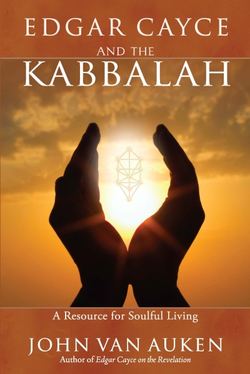Читать книгу Edgar Cayce and the Kabbalah - John Van Auken - Страница 12
На сайте Литреса книга снята с продажи.
The Beginning
ОглавлениеThe Kabbalah ties the invisible influences to the Creation story. It goes something like this. Before anything existed, there was nothing—absolutely nothing. Only infinite emptiness and stillness existed. This was the condition of the Creator before the Creation. How, then, could the Creation occur? How could something come from out of nothing? This is the mystery and the difficulty with our seeking to know God, to know the almost unknowable. However, if we think of this pre-Creation condition as a consciousness, an infinite, universal consciousness that was perfectly still, with no thoughts, then we can see how it could be empty and yet possess the power to conceive. The unseen gave birth to the seen. In this process, the initial expressions or emanations reflect the nature of the Unseen God, allowing us to know the God of pre-Creation to some degree, even though we are among the created, the seen. It also helps us to appreciate that the seen universe is within the unseen and was given life from the unseen, original essence that is pre-Creation God. We may think of it as the womb of our Mother’s mind.
What were some of the initial expressions of the infinite, universal mind of pre-Creation God? Well, at one moment there arose the will to create. This is the Divine Will motivated to create. Therefore, two of Unseen God’s qualities are Will and the Creative Forces.
The Kabbalah teaches that God had to make room for the Creation, so a portion of the pre-Creation Creator retreated into an unknowable, unreachable “place.” After this, the Creation exploded! The big bang of Life burst forth. And Kabbalah helps us understand the initial energies and original patterns through the ten emanations that reflect the nature of the invisible, infinite Creator into the visible reality. The emanations are in both the macrocosm and the microcosm. They are within us and flow through us. They are seen in the outer reality in a reflective manner, allowing us to intuit their unseen nature. And, best of all, we can awaken to them and use them to illuminate and energize our bodies, minds, and souls.
Living out here in the seen creation, we would be wiser and stronger if we opened our hearts and minds to the unseen Creative Forces and harmonized our free will with the flow of the Creator’s will.
Creation, in Kabbalah, is explained in this mystical manner: within the unbounded womb of “Infinite Nothingness,” that which is the essence of “Infinite Something” moved, expressing itself in a burst of “Light Without Limit.” This light is both consciousness and luminescence.
“Infinite Nothingness” is Ein (also spelled En and Ayn) and is comparable to Gnosticism’s “the Depth” and “Non–Being God” (ouk on theos) as well as “Unknown God” (hagnostos theos). “Infinite Something” is Ein Sof (also spelled Ein Soph, En Soph, and Ayn Sof) and is comparable to Gnosticism’s “Fullness of Being” (bythos pleroma). “Light Without Limit” is Ein Sof Aur, possibly comparable to Gnosticism’s “First Father” (propator).
The Infinite Something emanated ten aspects of itself and twenty-two channels of energy and consciousness. The Infinite’s expression flowed outward to four concentric planes of consciousness: (1) The first is concealed God, the Creator, the Infinite. It is a point in “the deep” (Genesis 1:2) that is everywhere and nowhere. It is unknowable but has emanated ten orbs of its nature, so it may be known by its emanations. These first ten emanations are known as the “Names of God,” each revealing a characteristic of the Ineffable One. This is the Plane of Emanations (Olam Azilut). (2) Around this infinite point is the second plane of consciousness and life, and in it are ten more emanations. These second ten emanations are “The Intelligences,” and are identified with the names of archangels. This is the Plane of Creation (Olam Briah). (3) Next comes the plane of consciousness and life called “The Hierarchies,” of which there are also ten emanations. It is the Plane of Formation (Olam Yetzirah). (4) Finally, we have the fourth plane of consciousness and life, the realms of matter and the material cosmos. It is the Plane of Activity (Olam Asiyah) This last plane is the visible one; all the others are invisible. (See illustration 12. We’ll cover more on these in chapter 4.)
There is a variation on this brief description, which teaches that the Infinite conceived of the Primordial Being first, and subsequently, the Primordial Being (or prototype) conceived all the beings. (See illustration 13.) This is comparable to Gnosticism’s idea that First Father conceived the central Monad (monas), an indivisible oneness that pervades all life, seen and unseen. This Monad is comparable to the Logos, the Word—as the disciple John wrote: “In the beginning was the Word, and the Word was with God, and the Word was God. All things were made through this One.” There is a First Source (proarche), which may be compared to Edgar Cayce’s “First Cause.” Humankind (anthropos) came out of the indivisible oneness of the Monad. In Kabbalah, humankind came out of the first being, Adam Kadmon.
We will learn much more about these as we continue our study.
